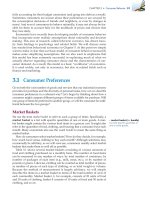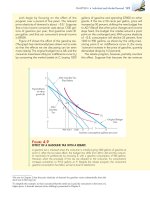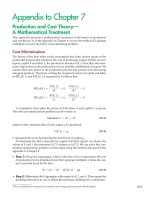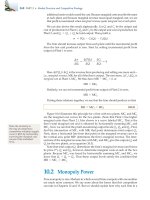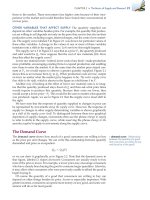(8th edition) (the pearson series in economics) robert pindyck, daniel rubinfeld microecon 122
Bạn đang xem bản rút gọn của tài liệu. Xem và tải ngay bản đầy đủ của tài liệu tại đây (115.54 KB, 1 trang )
CHAPTER 3 • Consumer Behavior 97
EX AMPLE 3. 7 MARGINAL UTILITY AND HAPPINESS
In Example 3.2 (page 81), we saw that
money (i.e., a higher income) can buy
happiness, at least to a degree. But what,
if anything, does research on consumer
satisfaction tell us about the relationship
between happiness and the concepts of
utility and marginal utility? Interestingly,
that research is consistent with a pattern
of diminishing marginal utility of income,
both in the U.S. and across countries.
To see why, let’s re-examine Figure 3.9
(page 82) in Example 3.2. The data suggest that as incomes increase from one country to the
next, satisfaction, happiness, or utility (we are using the
three words interchangeably) all increase as per-capita
income increases. The incremental increase in satisfaction, however, declines as income increases. If one is
willing to accept that the satisfaction index resulting
from the survey is a cardinal index, then
the results are consistent with a diminishing marginal utility of income.
The results for the U.S. are qualitatively
very similar to those for the 67 countries
that make up the data for Figure 3.9.
Figure 3.21 calculates the mean level of
life satisfaction for nine separate income
groups in the population; the lowest has
a mean income of $6,250, the next a
mean income of $16,250, and so on until
the highest group, whose mean income
is $87,500. The solid curve is the one that best fits the
data. Once again, we can see that reported happiness increases with income, but at a diminishing rate.
For those students concerned about future income
prospects, a recent survey by psychologist Daniel
Kahneman and economist Angus Deaton shows that
8.2
8
Satisfaction with Life
7.8
7.6
7.4
7.2
7
6.8
0
10000
20000
30000
40000
50000
60000
70000
80000
90000
100000
Income in 1999 U.S. $
F IGURE 3.21
MARGINAL UTILITY AND HAPPINESS
A comparison of mean levels of satisfaction with life across income classes in the United States shows that
happiness increases with income, but at a diminishing rate.

